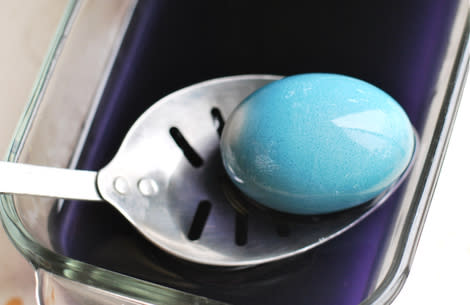Simple Step-By-Step Guide to Naturally Dyed Easter Eggs
I've long wanted to try dyeing Easter eggs naturally,
but shied away because it seemed so complicated. This year, I decided to dive in and crack the code. And you know what? It's really not complicated at all. In fact, naturally dyed Easter eggs are super fun to make. The process lends itself easily to experimentation and improvisation, and the results are gorgeous. The eggs are suffused with vibrant, deep, natural color, and are sure to lend warmth and beauty to your Easter celebration. Look ma - no chemicals!
There are two ways to approach naturally dyed Easter eggs. The first is to create your natural dyes and cold dip hard boiled eggs until you've achieved the desired color, anywhere from several minutes, to overnight in the fridge. For the beet-derived pinks, I found that boiling raw eggs in the dye was the best way to get an even color. See below for instructions on how to make each color.
The more of each ingredient you use, the richer and more potent your dye will be. For the most part, I went with a weaker solution and soaked most of my eggs overnight. If you're dyeing with kids, it might be more fun to have a stronger solution and soak the eggs for a shorter stint-so, unless otherwise noted, my instructions above are for a strong solution that should color eggs within a half hour.
Related: 25 artistic ways to decorate Easter eggs
1. Beets for pink dye
4 cups red beets, rough chopped
2 tablespoons vinegar
1 teaspoon salt
1 quart water
Combine the beets, vinegar, salt and 1 quart of water, bring to a boil, and then simmer uncovered for 30 minutes. Strain the beets, and set the liquid aside.
Pink eggs
Place the hot liquid in a small saucepan, add the desired number of raw eggs, and bring back up to a boil. Cook for 12 minutes, and then turn off heat and steep the eggs for another 20 minutes. Stir occasionally for more even color.
Related: 14 ways to make your own Easter basket
2. Tumeric for yellow dye
4 tablespoons ground tumeric
2 tablespoons vinegar
1 teaspoon salt
1 quart water
Combine the tumeric, vinegar, salt and water, bring to a boil, and then simmer uncovered for 30 minutes.
Yellow eggs
Once the liquid has cooled, dip hard boiled eggs in the solution. They will turn a light yellow very quickly, and will take on a vivid hue if soaked overnight in the fridge.
Related: 16 sweet vegan treats to serve on Easter
3. Cabbage leaves for blue dye
14 cups purple cabbage leaves, rough chopped
2 tablespoons vinegar
1 teaspoon salt
1 quart water
Combine the cabbage, vinegar, salt and 1 quart of water, bring to a boil, and then simmer uncovered for 30 minutes. Strain the beets, and set the liquid aside.

Blue eggs
Once the liquid has cooled, dip hard boiled eggs in the solution. They will turn a light blue very quickly, and will turn dark blue if soaked overnight in the fridge.
- By Brooke Mclay
Follow Brooke on Babble
For 2 more Easter egg dyes you can make naturally, visit Babble!
MORE ON BABBLE
21 tips for growing a garden in your windowsill
9 ways to save money on Easter dinner
The 5 best flowers to plant this spring
10 simple changes you can make to go green this year
7 ways to dress up your backyard with a garden

